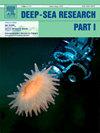深海气泡羽流的光声综合监测——以海马冷渗为例
IF 2.1
3区 地球科学
Q2 OCEANOGRAPHY
Deep-Sea Research Part I-Oceanographic Research Papers
Pub Date : 2025-10-08
DOI:10.1016/j.dsr.2025.104603
引用次数: 0
摘要
监测水下气泡羽流对了解其对海洋生态系统的影响起着至关重要的作用。本文设计并实现了一种光学与声学相结合的深海气泡羽观测系统。该系统部署在海马冷渗1386 m深度,共收集了4.5 h的光学和声学记录。此外,还开发了针对光学和声学数据的定制化处理方法:利用卷积神经网络(CNN)识别光学数据流中的单个气泡,利用集成单元平均恒定虚警率(CA-CFAR)检测器的被动声学气泡检测方法解决人为干扰,利用抛物线插值提高主动声学观测时延估计的分辨率。所有收集到的数据都进行了全面的处理和分析。视频数据的定量分析得出平均气泡半径为2.35 mm,气体通量为0.052 L/min ~ 0.086 L/min。从主动声波数据中获得的声速随频率的变化与现有的气泡液体线性压力波传播理论很好地吻合,表明深海气泡以可预测的方式影响声速。该研究代表了用于深海气泡羽流原位监测的光学和声学集成系统的重要早期发展,为未来相关仪器和数据分析算法的迭代提供了有价值的见解和实际考虑。本文章由计算机程序翻译,如有差异,请以英文原文为准。
Integrated optical and acoustic monitoring of deep-sea bubble plume – A case study in Haima cold seep
Monitoring underwater bubble plumes plays a vital role in understanding the plumes’ impacts on marine ecosystems. In this study, an integrated optical and acoustic deep-sea bubble plume observation system was designed and presented. The system was deployed in the Haima cold seep at a depth of 1,386 m, where a total of 4.5 h of optical and acoustic recordings were collected. Customized methods for processing both optical and acoustic data were also developed: a convolutional neural network (CNN) was used to identify individual bubbles from optical data stream, a passive acoustic bubble detection method integrating cell averaging constant false alarm rate (CA-CFAR) detector was applied to address human-induced interferences, and parabolic interpolation was employed to improve the resolution of time delay estimation for active acoustic observation. All the collected data were comprehensively processed and analyzed. The quantitative analysis of the video data yielded a mean bubble radius of 2.35 mm, and a gas flux ranging from 0.052 L/min to 0.086 L/min. The frequency-dependent sound speed variations obtained from the active acoustic data align well with existing theory on linear pressure wave propagation in bubbly liquid, suggesting the deep-sea bubbles influence the sound speed in predictable ways. This study represents an important early development of an integrated optical and acoustic system for in-situ deep-sea bubble plume monitoring, offering valuable insights and practical considerations for future iterations of related instrumentation and data analysis algorithms.
求助全文
通过发布文献求助,成功后即可免费获取论文全文。
去求助
来源期刊
CiteScore
4.60
自引率
4.20%
发文量
144
审稿时长
18.3 weeks
期刊介绍:
Deep-Sea Research Part I: Oceanographic Research Papers is devoted to the publication of the results of original scientific research, including theoretical work of evident oceanographic applicability; and the solution of instrumental or methodological problems with evidence of successful use. The journal is distinguished by its interdisciplinary nature and its breadth, covering the geological, physical, chemical and biological aspects of the ocean and its boundaries with the sea floor and the atmosphere. In addition to regular "Research Papers" and "Instruments and Methods" papers, briefer communications may be published as "Notes". Supplemental matter, such as extensive data tables or graphs and multimedia content, may be published as electronic appendices.

 求助内容:
求助内容: 应助结果提醒方式:
应助结果提醒方式:


